I thought about this little episode after Pierre Boulez’ recent passing.
Years ago, while working in Paris teaching ESL to middle managers at a French language school, I splurged and bought two tickets to the Béjart Ballet. I wasn’t making great money so this was a big expense. I had a hot first date, however, and wanted to have a special night out.
Michele Kinloch–I still remember my date’s name–and I arrived at the venue, which I recall was the Palais des Congrès, and the first piece had music by the late Pierre Boulez, which I hated. It was angular and awkward and irritating, and took away from the dancing and choreography. I just will never like this sort of modern music, sorry. I like Boulez as a conductor, but find him a little cold and analytical for my taste. Give me Bernstein or Monteux or Previn instead.
The next pieces were romantic pieces done to the music of Mahler, I think the gorgeous slow adagios / adagiettos from the 3rd and 5th symphonies. This was sumptuous and romantic music, and with the dance it was overwhelmingly moving. I was moved to tears by it all. My date seemed to enjoy it. I, however, was totally smitten and was in sort of a puddle at the end, and forgot to bring Kleenex.
We went out to a nice restaurant after that, where I spent the rest of my money. I had just enough to take the metro back to the 16th arrondissement, where Michele lived with her parents. Did I tell you I met her at the school I was teaching at, the École Universelle, also in the 16th, the Beverly Hills of Paris? There we drank some of her parents’ cognac. Some cork fell into my glass and I drank it, as I was told that swallowing a little cork was good luck.
The problem was that I had to walk all the way back from the 16th to the 14th, where I had a tiny cold water flat. The metro stopped running at 12:45, and I didn’t even have enough change for the bus. And so I walked.
I checked my guidebook, my Plan de Paris, and decided on a shortcut, taking side streets instead of the bigger boulevards. This proved to be a costly mistake.
In a little while I was stopped and asked directions by a group of men who seemed a little out of it. I thought they were drunk. I dutifully obliged them, spreading out my Paris map on the top of a car. They kept asking me questions as if they were not understanding my directions. What they were really doing was checking out the gold watch on my outstretched arm and exposed wrist that my dad had given me.
A few minutes later I was approached by a group of men, hit hard in the head, and fell to the ground where I was kicked in the head some more. I was unconscious when I heard the sound of a gun going off. I thought to myself “So this is the way I’m going to die”. A 24-hour plumber was working nearby and saw the assault and mugging. He picked me up off the pavement, helped me stagger to his little deux chevaux camion (small truck) and, handing me a pistol, told me that we were going to go get those bastards. I folded the window up and waited for directions. I was still pretty out of it. I don’t like guns, never have, but would have pulled the trigger if the plumber told me we’d found the guys and told me to fire.
We didn’t catch the culprits and the good Samaritan plumber took me to the nearest police station. I sat in the waiting room. A working woman was sitting near me, and came over. “Ah, mon pauvre cheri, vous êtes blessé”. She wiped some of the blood off my head with her mouchoir. Suddenly she turned on me and started hurling expletives. She also hit me on the head and re-opened my head wound.
I had a small amount of useless Congolese ganja in my pocket and panicked that the police would arrest me if they found out. I went into the bathroom and was about to toss it into the urinal when I noticed the big convex wide-angle mirror with the watchful eyeball of a policeman watching my every move. Great. Now I won’t get a work permit. Maybe even get deported.
Eventually the police took me to the indigent hospital nearby, run by l’Assistance Publique, rue Vaugirard. I should have requested the American Hospital in Neuilly but didn’t. I was x-rayed by a technician for a long time…he just kept taking x-rays. Eventually I noticed that he was taking hearty swigs out of a wine bottle. No wonder he couldn’t get it right. After that another man came, sprayed my forehead with antiseptic spray, and stuck a horse needle in with some very crude stitches.
I was led up to a room filled with people and assigned a cot. Trouble was, the man in the cot next to me was moaning and wheezing like he was about to expire. I couldn’t stand it, but when he stopped wheezing, I was even more alarmed, fearing he’d died. I wanted to escape this medieval hospital and got up to leave. A large woman stopped me and sent me back to my bed.
In the morning I signed some papers saying I was refusing doctor’s care. I walked to the nearest metro and took a seat. People who saw the blood matted in my hair and on my clothing moved away from me. It was nice having a little space on the morning commute to myself.
I never saw Michele Kinloch again. And I still don’t care for Boulez’ acrid music. Not bad for a first date. But I still have a scar to prove it wasn’t all just a crazy dream!
I’m near Chris Burden’s age, so some of my life story aligns with his. One of those intersections was the Vietnam War, or The American War, as it’s known in Vietnam and some other places. I never wanted to serve in Vietnam, and moved to Paris to go to school and took my Army physical in Germany. In Los Angeles you would be inducted no matter what. There was a big quota to fill. I had high school chums who got killed there, and other friends who returned psychologically damaged. As we know now, it was a trumped up war, as McNamara admitted later on; we should have learned from the French debacle but didn’t.
Burden, who died yesterday at 69 of melanoma, lived in Los Angeles, had a studio in Topanga Canyon, and taught at UCLA, my alma mater. Although he is best known for his extreme conceptual / performance piece, Shoot (1971), a personal reaction to the Vietnam War and all the people being shot and killed there, and many of his shows in various LA galleries, the piece I most remember was at the Museum of Modern Art in 1992: It was called The Other Vietnam Memorial, a counterpoint to Maya Lin’s huge Washington D.C. Vietnam Veterans Memorial.
It was an immense series of revolving copper plates, 13′ tall, and filled with etched names of the three million war dead, including the 57,939 American fatalities and the more than two and a half million Vietnamese dead, both military and civilian. He gathered the names from Vietnames phone books. You would move the huge heavy sheets around like you would in a poster shop with large posters. It is one thing to think 3 million people; it is another thing to behold and digest just how many human beings those names represent.
It was powerful and truth be told I just fell apart in the museum that day. Seeing the enormity such loss was devastating.





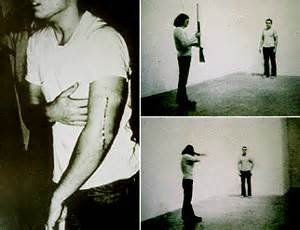
I had the good fortune to attend yesterday’s 5th annual Concours d’Elegance in Beverly Hills at the 1920’s Greystone Mansion, organized and presented by the City of Beverly Hills and Friends of the Greystone. I took a few photos, many of the famous cars’ emblems, symbolic of the brand heritage and design.
There were plenty of coveted Porsche 356 Speedsters, the precursor to the 911, which arrived in 1963. There was the Ferrari Lusso, favorite Ferrari of Steve McQueen, memorialized in a book by jazz photographer William Claxton. There was the Ferrari Dino, the first rear-engine design for the legendary Italian car maker (Enzo Ferrari is said to have remarked when being challenged by rear-engined Porsches “the horse doesn’t push the cart”). The Dino also was a memorial to Enzo’s son Dino, who died if muscular dystrophy in 1956 at the age of 24). (sorry the image is sideways and I can’t fix that). There was also a couple of Ferrari 275 GTB’s, one of the last of the front-engined classic V12 cars in the 1960s, before Ferrari started using six and eight-cylinder engines. I stole my dad’s 275 out of the garage one night for a joyride a long time ago. There is no sound as beautiful as a Ferrari front engine V-12. It is music to the ears.
There were some classic 1950s American cars, including an Oldmobile and a Pontiac (see pix of logos). 1950’s American cars often had jet-age elements, as you see on the Pontiac hood ornament. Another jet age reference, the Olds Rocket 88 also launched the first rock and roll r&b classic, Jackie Brenston’s song “Rocket 88” (song is here: http://blogs.kcrw.com/rhythmplanet/jackie-brenston-rocket-88-and-the-demise-of-oldsmobile/) A couple of Mercedes Benz 300sl Gullwings, both with matching luggage. My dad has a 300sl Gullwing with matching crimson luggage; my mother hated the car because it was so hard to get in and out of…just try it sometime! It didn’t help things that the cab always smelled of gasoline!
The Alfa Romeo emblem is a 14th century Milanese family crest (Alfa is based in Milan). Two European luxury cars popular among the elite in Europe, Hollywood celebrities and French writers. The Dual Ghia was a favorite of Dean Martin and Frank Sinatra and other Rat Pack members. (again sorry I can’t flip the image). Albert Camus, the existential French-Algerian writer who mused on death and suicide died in the French-made Facel Vega while driving back to Paris with his publisher Michel Gallimard.
The world’s smallest woody, a Morris mini-minor, complete with surfboards; another English classic, a 1970s-vintage Rolls Royce with a picnic ready to be enjoyed. There was also an early Rolls with the red hood logo; it has been commonly believed that the logo went from red to black after the death of Henry Royce in 1932–not true–the color was changed to go better with new exterior colors. We also see the super-powerful turbocharged Bentley Blower from the 1920s, a car to be reckoned with in early auto road racing. Another British classic is the 3-wheeled Morgan.
Then there is a classic 1963 VW Bug, complete with large accordion sunroof.
There were a lot of other cars, too many to mention in this post. Also many classic motorcycles. I wish there had been a Citroen DS and maybe some classic Maseratis, as Maserati is making a comeback in the U.S. Nevertheless it was a enjoyable time for all auto enthusiasts, collectors, and spectators.

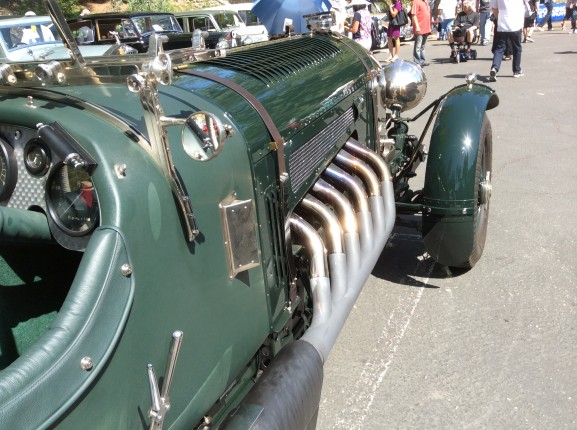 20’s Bentley Blower
20’s Bentley Blower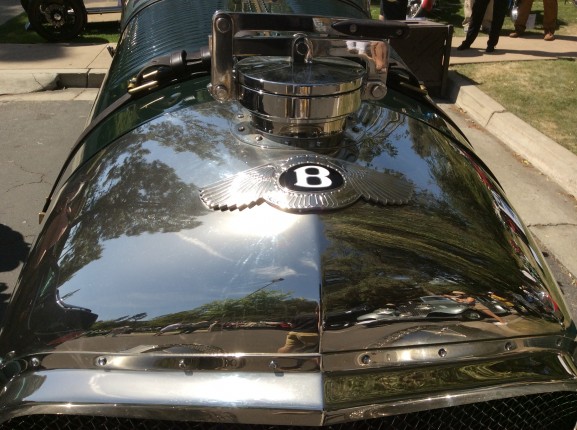
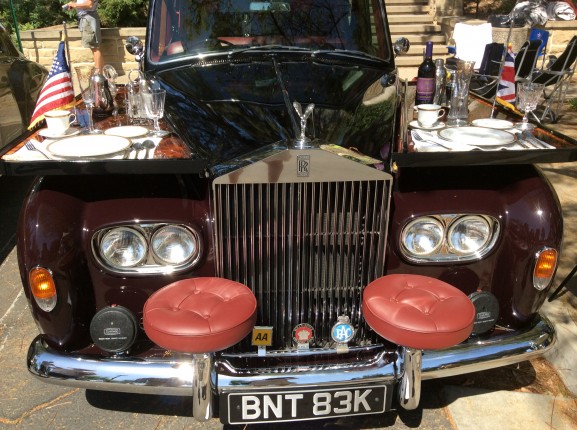 1972 Rolls Royce
1972 Rolls Royce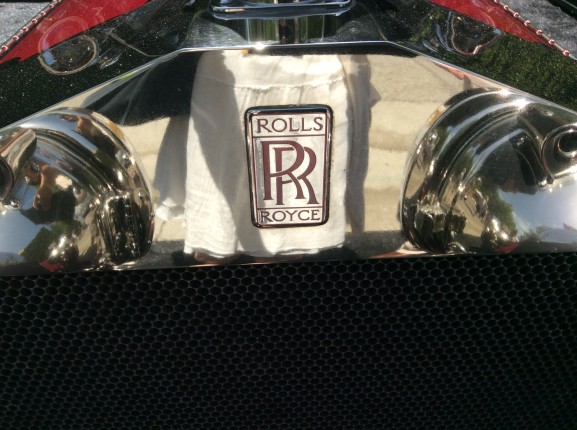 Early Rolls with Red lettering
Early Rolls with Red lettering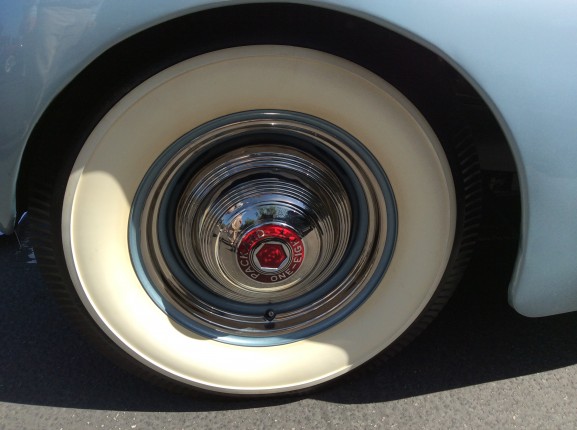 1930s Packard
1930s Packard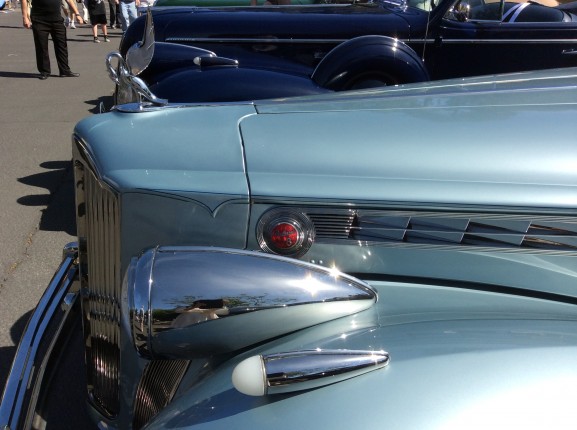
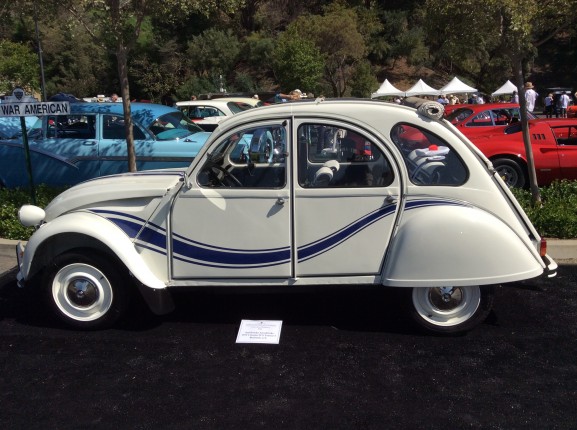 Citroen 2cv, only Citroen there.
Citroen 2cv, only Citroen there.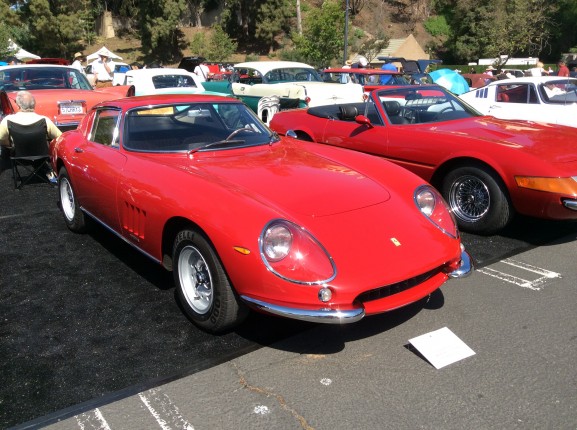 Ferrari 275 GTB, classic V-12
Ferrari 275 GTB, classic V-12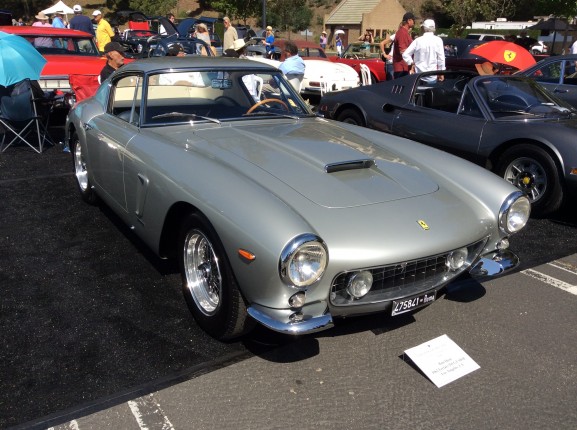 Steve McQueen’s fave: Lusso
Steve McQueen’s fave: Lusso
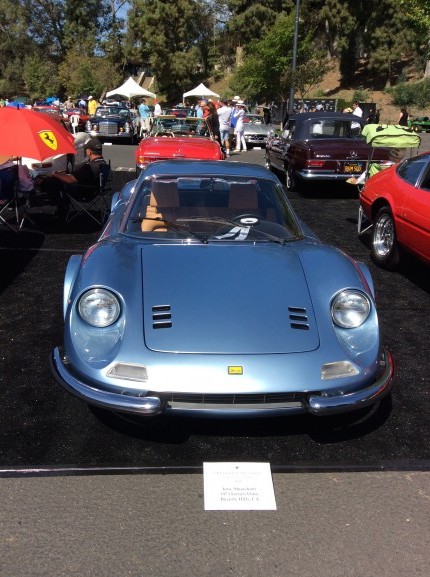 Ferrari Dino, so named after his early death.
Ferrari Dino, so named after his early death.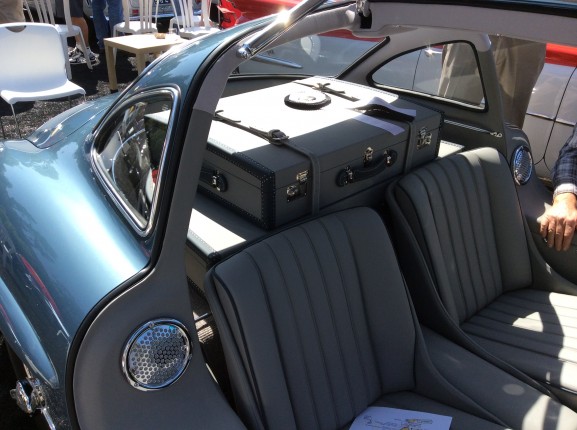 Mercedes Benz 300sl w. luggage
Mercedes Benz 300sl w. luggage
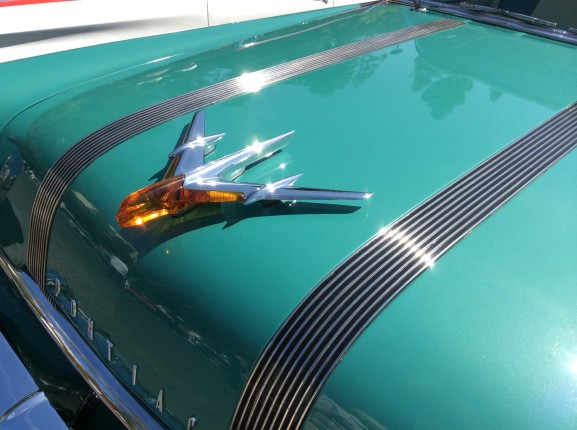 50’s Pontiac hood ornament
50’s Pontiac hood ornament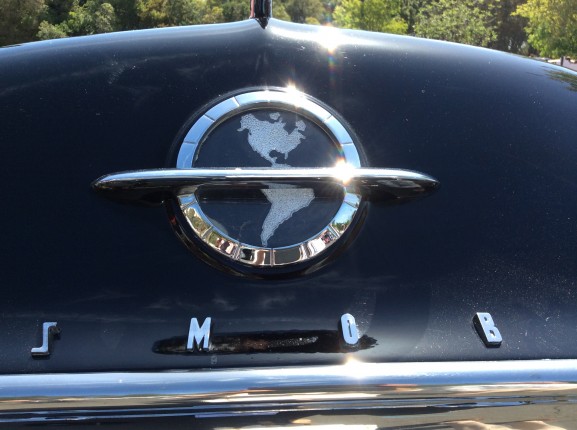 Oldsmobile logo
Oldsmobile logo Alfa’s Milanese family crest
Alfa’s Milanese family crest Morgan 3-wheeler
Morgan 3-wheeler Surf’s up on Brighton Beach!
Surf’s up on Brighton Beach!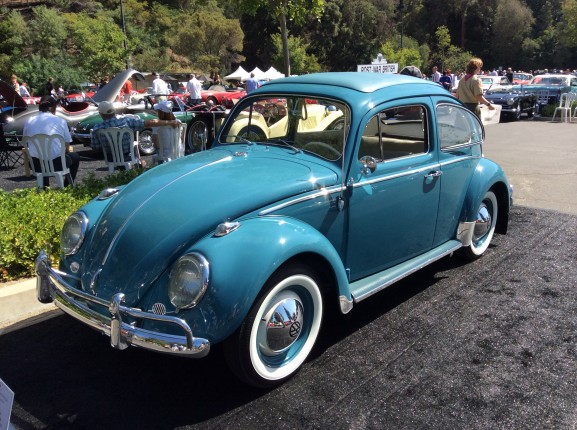 Everybody’s favorite, a ’63 Bug
Everybody’s favorite, a ’63 Bug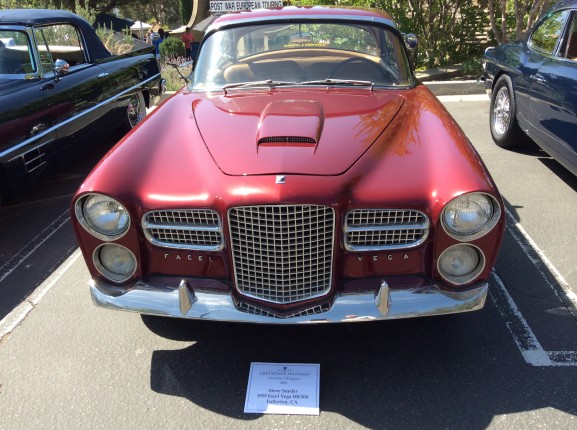 Facel Vega: Camus died in one
Facel Vega: Camus died in one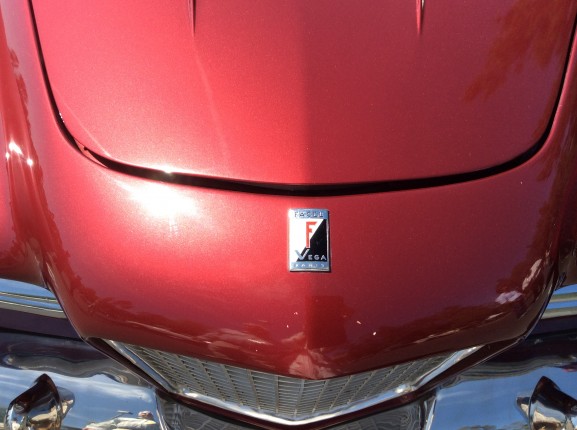
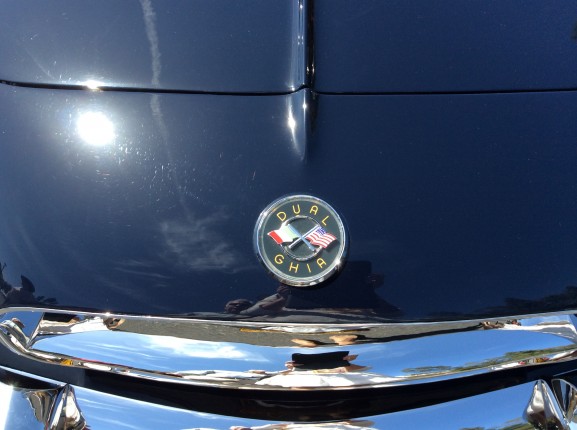
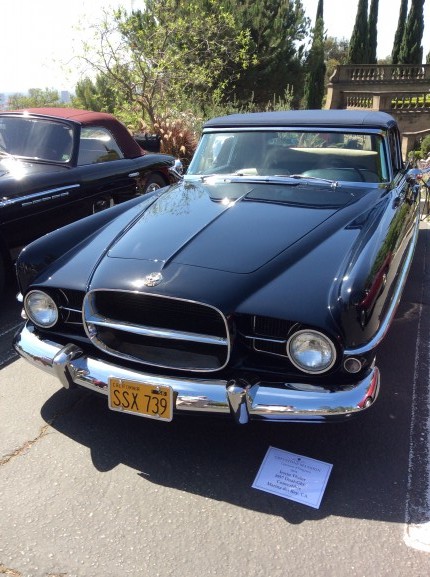 Dual Ghia: Rat Pack’s car of choice
Dual Ghia: Rat Pack’s car of choice
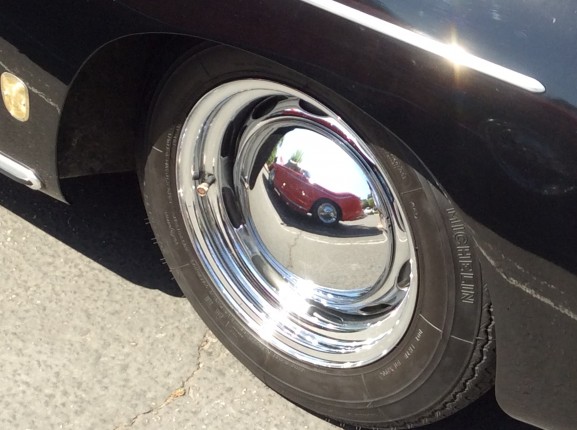 356 Porsche Speedster
356 Porsche Speedster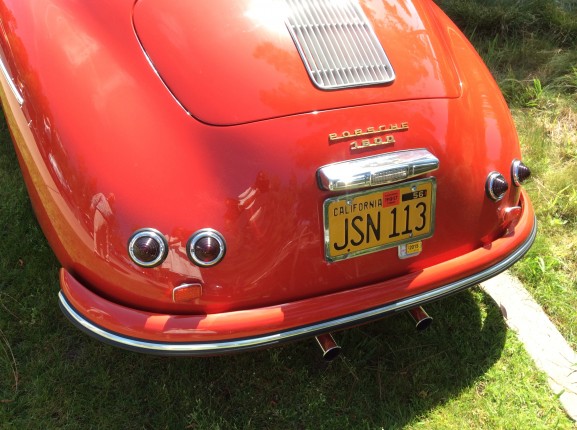 early Speedster (note early plate)
early Speedster (note early plate)
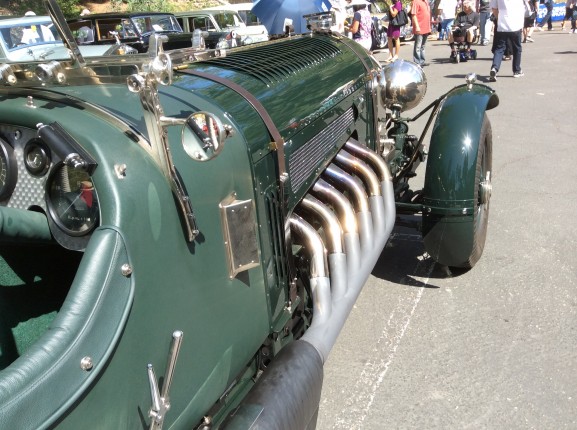 Bentley Blower 1920s
Bentley Blower 1920s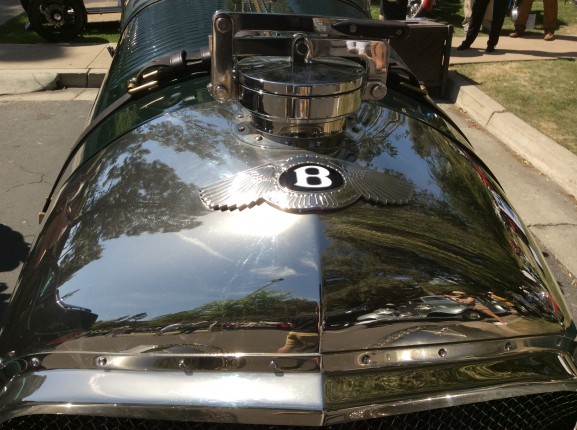 Bentley Blower
Bentley Blower
photo credits: Cherie Chen

 Touring of Milan was the Italian coach builder for the most beautiful Alfa Romeos and Bond-era Aston Martins. Superleggera means “superlight”.
Touring of Milan was the Italian coach builder for the most beautiful Alfa Romeos and Bond-era Aston Martins. Superleggera means “superlight”.

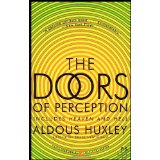


LSD has had a complicated history ever since a Swiss chemist, Dr. Albert Hoffman, discovered it by accident back in the 1940s. It was used by the CIA in experiments, by Hollywood stars in the 1950s, and was huge among the hippies and mind-adventurers in the 1960s. It was banned in the U.S. in 1966.
Now, another Swiss doctor, this time a psychiatrist named Dr. Peter Gasser. He is administering the drug to end-of-life patients, who are having mystical experiences and who reported less anxiety and a more positive approach to death. One patient said “I will say I have been more emotional since the study ended, and I don’t mean always cheerful……but I think it’s better to feel things strongly–better to be alive than to merely function”.
The New York Times piece was published yesterday. Here is the link:
http://www.nytimes.com/2014/03/04/health/lsd-reconsidered-for-therapy.html?_r=0
The article reminded me of Aldous Huxley, British novelist and visionary. His book The Doors of Perception was widely read in the 1960 and still is today; it chronicles his experience taking mescaline in the 1950s, while living here in Los Angeles. The band The Doors took its name from Huxley’s book.
As Huxley was dying here in late 1963, he asked his wife Laura to give him an injection of LSD so he could fully experience his own demise. On that dark day in history—when JFK was assassinated–Huxley reportedly died a death of serenity and bliss.
There was a front page article in today’s New York Times : Textile Plants Humming, but Not with Workers
http://www.nytimes.com/2013/09/20/business/us-textile-factories-return.html?ref=todayspaper
Despite the upswing in textile manufacturing here in the U.S., many workers are being laid off due to automation. This situation recalls a similar one many years ago. Dutch textile workers during the Industrial Revolution were being laid off as textile mills became industrialized. They protested by throwing their Dutch wooden shoes, called sabots because they resembled the small wooden sailboat, into the machinery and disrupting production, sometimes ruining the mills. The resulting act and word became known as “sabotage”.
My old friend from UCLA grad school days, Mark Squires, sent this comment, which is so interesting I am compelled to include it here:
“Tom, my historical sources, though not universally accepted, differ somewhat from the NYT’s story that”sabotage” derived from Dutch textile-mill-workers throwing a ”sabot,” a small wooden shoe named after a small wooden boat, into the machinery. A retired intelligence official tells me that, originally, the disgruntled workers threw the entire boats into the machinery – a very effective tactic. But the capitalists’ agents soon learned to sniff out which workers were carrying boats into factories. The workers adapted by carrying in smaller and smaller boats; and this growing demand eventually led to boats only the size of a shoe (and this, though interesting for surfers, led inevitably to the decline of the Dutch whaling industry).”



When I was 12 and 13, cycling was everything to me. I rode around 100-150 miles weekly, was on an informal team called “Le Voyageurs” (The Travelers), complete with jerseys, chamois-seated shorts, toe clips, the whole deal. A weekend ride would have us all ride from Santa Monica Canyon up PCH to Malibu Canyon Road, then up to Mulholland, and out to Malibu Lake. Then back home again. It was a long ride. The ultimate prize was going up Tuna Canyon road, just north of Topanga Canyon, without getting up off the saddle. I subscribed to a UK magazine called Sporting Cyclist, reading about the Saeco and St. Raphael Geminiani teams, the great Louis Bobet, Jacques Anquetil, and the disgraced UK cyclist Tom Simpson, who was busted for doping. Yes, I’m dating myself….this was a long time ago. This was before I went beserk for surfing.
One day, driving with my mother down Lincoln Boulevard near Westchester’s LMU, we stopped at a bike store where I beheld a beautiful Italian racing bike….a Legnano. It was all-Campy–all Campagnolo components, then the Dom Perignon of derailleurs, brakes, head stems, seat posts, chain sets. Beautiful Italian duraluminum that could have been designed by Leonardo da Vinci. I lusted and longed for that bike. It cost $199.00. My mother said no and I remained stuck with my older brother’s hand-me-down. Later I saved lunch money for three months and bought a Raleigh Grand Prix. But I never forgot the Legnano. It was the bike that got away.
It reminded me of a story I heard once on NPR: a kid who wanted a certain baseball glove for Christmas. He cut out pictures and showed them to his parents. He made it clear that this was the glove he wanted….it had some famous player’s name on it. Christmas came, and the little guy was almost peeing in his pants as he opened a square package smelling of neats foot oil, the stuff they put on baseball gloves. He opened the box and ! was devastated. Instead of the prized $20 glove, it was a cheap knock-off that his parents bought for five dollars. For them it was all the same. For him it was completely different, and painful.
Don’t ask me why, but I looked up this coveted Italian bike that never was, and found a link. Here it is: even in the same chartreuse color I remember so well:
http://www.biciclassiche.com/2013/02/legnano-roma-olimpiade-1960-61.html

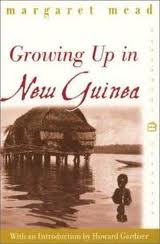

The Hopi nation of native Americans is outraged about a recent sale of Hopi masks whose sale was approved by a French court and sold at auction for $1.2 million. The Hopis consider these masks sacred, unlike the art world which considers them mere cultural artifacts which can be bought and sold. Read More →
Having recently undergone shoulder surgery, on pain meds and having to take ambien because I’m forced to wear a brace and sleep sitting up on my back, I am watching tv more. After finding nothing else on, bored and finding it difficult to hold a book in one hand with my brace on, I turn to local stations for the tabloid news, and out it comes: more guns, murders, mayhem.
The gun debate flared up after New Town and again with Christopher Dorner. Now we have a 20 year-old kid from an upscale neighborhood near Laguna Hills go on a murder spree, killing both in his own home while his parents slept upstairs unawares; yesterday ‘words were exchanged’ between an aspiring hip hop artist and some gangsters in a darkened-window Range Rover kill him in his Lamborghini, taking a few other innocents with them. An Anaheim 7-11 is robbed and the poor clerk is shot and pistol-whipped by some thug in a hoodie and facemask.
When will it stop? Why is America so addicted to guns? The 20 year old was a loner addicted to violent video games…..gee, where have we heard that before? Aurora? New Town? Read More →
There is a huge manhunt for Christopher Dorner going on right now. He has already murdered three people, and is doubly dangerous because of his military training as well his LAPD training. It is a cop’s nightmare to deal with a skilled marksman who has snapped, gone on a rampage and wants to go out in flames.
As I watched TV last night, it occurred to me that the weirdest thing is that he has a million dollar smile in every photo. He looks like the sweetest guy in the world.
You can’t tell a book by its cover, the old saying goes. You don’t know what is lurking in the mind of the nicest looking person standing next to you. My heart breaks for the beautiful young couple, recently engaged, that he murdered over the weekend. And for the family of the LAPD cop he killed this morning Who knows how it will end, but it certainly will not be pretty.
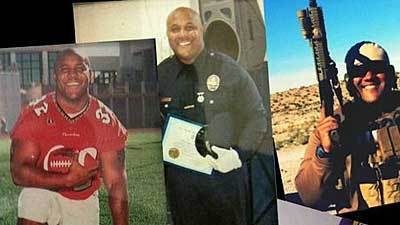
To comment, click Read More →

 It’s common knowledge that the Philippines have long been dominated by foreign powers. The Spanish, then the Americans, then the dictators the U.S. propped up (Ferdinand Marcos and his ridiculous first lady Imelda, who squandered tens if not hundreds of thousand dollars on shoe blitzes in New York City). America did this because we needed our big military bases back in the Vietnam days.
It’s common knowledge that the Philippines have long been dominated by foreign powers. The Spanish, then the Americans, then the dictators the U.S. propped up (Ferdinand Marcos and his ridiculous first lady Imelda, who squandered tens if not hundreds of thousand dollars on shoe blitzes in New York City). America did this because we needed our big military bases back in the Vietnam days.
Then there was Cardinal Sin (couldn’t have made that one up) who told his vast flock that God wanted them to make as many babies as possible. Every time I saw images of children picking through landfills I thought of him.
And now, despite the Catholic Bishops’ conference warning that “contraception corrupts the soul”, the Philippine Congress approved contraceptive legislation that would make birth control available to all in the Philippines. Read More →



While in college I read an influential book by Joseph Campbell called The Hero with a Thousand Faces. It was his first and still his most popular and influential book. In it he told of how we mythologize heroes in our daily lives, and these heros represent the cultural mass and mores. One famous quote is as follows: “A hero ventures forth from the world of common day into a region of supernatural wonder: fabulous forces are there encountered and a decisive victory is won, the hero comes back from this mysterious adventure with the power to bestow boons on his fellow man. George Lucas, for instance, was influenced by Campbell’s “monomyths” in the making of Star Wars. But I don’t think Campbell was thinking about our current crop of action films and the heroes they present to us.
Read More →

In 1973, fresh out of grad school and after an unhappy spell in law school, unable to find a job teaching in American community colleges, I found two job postings on a UCLA international job bulletin board. One was to teach English at a brand new university in Constantine, Algeria. The other was a teaching post at a University in Shiraz, Iran.
What grabbed me about the University of Constantine was the gorgeous futurist architecture of the great Brazilian architect Oscar Niemeyer, who has recently celebrated his 104th birthday. He once beautifully stated:
“I am not attracted to straight angles or to the straight line, hard and inflexible, created by man. I am attracted to free-flowing, sensual curves……the curves that I find in the mountains of my country, in the sinuousness of its rivers, in the waves of the ocean, and on the body of a beloved woman.”
Who could resist this? Plus, I’d lived in Paris before and spoke French. So I applied. Read More →
The other night we hosted a dinner party. One of our guests worked at JPL. I brought out my copy of the box set Murmurs of Earth, published by Time Warner about 20 years ago. It’s one of the box sets I saved when moving and downsizing last summer, because it’s rare and amazing.
The Voyager Spacecraft has fascinated me, not because I have a scientific mind, but because there are so many interesting things about it. Among them are the fact that President Jimmy Carter wrote a letter, put on the time capsule aboard the spacecraft, that implied an awareness that otherworldly civilizations might be out there. Second, that there was a music soundtrack on the time capsule, put together by Carl Sagan and Alan Lomax, that included classical music, jazz, blues, and world music. Third, that Voyager is still out there, 40 million+ miles away, still pinging earth from deep space after 35 years.
Jimmy Carter once saw what he thought was a UFO. Read More →

I once saw a bumper sticker that read “Stupidity Should be Painful”. This was years ago and I still remember it. And agree with it too.
I don’t want to sound like an overeducated snob. But I believe that an electorate that turns solely to Fox News and Rush Limbaugh instead of reading and listening to a variety of news sources and books will be a dumb and irresponsible public. The fact that we live in times where access to information is at its best, there is no excuse to resort to the basest and lowest common denominator, one geared to generating ratings and advertising dollars rather than educating and enlightening it’s viewing and listening audience.
I’m now reading an interesting book by Stephen Greenblatt called The Swerve: How the World Became Modern. The book is about an Italian’s discovery, in Germany in the early 15th century, of an ancient Roman philosophical and epic poem by Lucretius called On The Nature of Things. Read More →
I subscribe to the New Yorker, even though like many people, I don’t have the time to read every issue. Shortly after this week’s Super Tuesday, this issue arrived in the mail. I didn’t quite know what to make of the cover, then I found Gail Collins’ very funny piece–in her New York Times column– on Seamus the Irish Setter and the Romney family road trip to Canada in 1983. It is very funny, and helps you understand the cover of the current issue. Read More →

 The Grammy Awards will be given out tonight. The TV broadcast, watched by millions, will feature the largest categories and biggest, most well-known stars. But there are hundreds of other musical acts you’ll never hear there. And then the 31 roots categories that NARAS eliminated from this year’s voting. Read More →
The Grammy Awards will be given out tonight. The TV broadcast, watched by millions, will feature the largest categories and biggest, most well-known stars. But there are hundreds of other musical acts you’ll never hear there. And then the 31 roots categories that NARAS eliminated from this year’s voting. Read More →
I have loved African music for over thirty years. I discovered it through Olatunji’s seminal Columbia lp Drums of Passion and the great Congolese mass Missa Luba years ago. I first heard Afro pop while living in Paris in the 1970s. Congolese rumba was especially sweet and intoxicating. Later came the great Afro-Cuban grooves of bands like Guinea’s Bembeya Jazz and Orchestra Baobab from Dakar, Senegal. This is truly joyful noise.
Yet when I read in the newspapers about the Lord’s Resistance Army, hear the Refugee All-Stars (a Sierra Leone group of survivors of the war there), the Congolese murders or Rwandan genocide, it’s hard to square the violence with the sweet soulfulness of the music. Read More →
 I wanted to alert you to a nice articule in today’s LA Times, “Bhutan Rejoices as King Marries Student”. I’m sending this because last Sunday we featured on my show an interview with Lisa Napoli on her wonderful book Radio Shangri-La: What I Learned in Bhutan, the Happiest Place on Earth.
I wanted to alert you to a nice articule in today’s LA Times, “Bhutan Rejoices as King Marries Student”. I’m sending this because last Sunday we featured on my show an interview with Lisa Napoli on her wonderful book Radio Shangri-La: What I Learned in Bhutan, the Happiest Place on Earth.
http://www.kcrw.com/music/programs/cl/cl111009lisa_napoli
We listened to all sorts of music from this remote and little-known country. Read More →








 20’s Bentley Blower
20’s Bentley Blower
 1972 Rolls Royce
1972 Rolls Royce Early Rolls with Red lettering
Early Rolls with Red lettering 1930s Packard
1930s Packard
 Citroen 2cv, only Citroen there.
Citroen 2cv, only Citroen there. Ferrari 275 GTB, classic V-12
Ferrari 275 GTB, classic V-12 Steve McQueen’s fave: Lusso
Steve McQueen’s fave: Lusso Ferrari Dino, so named after his early death.
Ferrari Dino, so named after his early death. Mercedes Benz 300sl w. luggage
Mercedes Benz 300sl w. luggage 50’s Pontiac hood ornament
50’s Pontiac hood ornament Oldsmobile logo
Oldsmobile logo Alfa’s Milanese family crest
Alfa’s Milanese family crest Morgan 3-wheeler
Morgan 3-wheeler Surf’s up on Brighton Beach!
Surf’s up on Brighton Beach! Everybody’s favorite, a ’63 Bug
Everybody’s favorite, a ’63 Bug Facel Vega: Camus died in one
Facel Vega: Camus died in one

 Dual Ghia: Rat Pack’s car of choice
Dual Ghia: Rat Pack’s car of choice 356 Porsche Speedster
356 Porsche Speedster early Speedster (note early plate)
early Speedster (note early plate) Bentley Blower 1920s
Bentley Blower 1920s Bentley Blower
Bentley Blower
 Touring of Milan was the Italian coach builder for the most beautiful Alfa Romeos and Bond-era Aston Martins. Superleggera means “superlight”.
Touring of Milan was the Italian coach builder for the most beautiful Alfa Romeos and Bond-era Aston Martins. Superleggera means “superlight”.










 It’s common knowledge that the Philippines have long been dominated by foreign powers. The Spanish, then the Americans, then the dictators the U.S. propped up (Ferdinand Marcos and his ridiculous first lady Imelda, who squandered tens if not hundreds of thousand dollars on shoe blitzes in New York City). America did this because we needed our big military bases back in the Vietnam days.
It’s common knowledge that the Philippines have long been dominated by foreign powers. The Spanish, then the Americans, then the dictators the U.S. propped up (Ferdinand Marcos and his ridiculous first lady Imelda, who squandered tens if not hundreds of thousand dollars on shoe blitzes in New York City). America did this because we needed our big military bases back in the Vietnam days.





 The Grammy Awards will be given out tonight. The TV broadcast, watched by millions, will feature the largest categories and biggest, most well-known stars. But there are hundreds of other musical acts you’ll never hear there. And then the 31 roots categories that NARAS eliminated from this year’s voting.
The Grammy Awards will be given out tonight. The TV broadcast, watched by millions, will feature the largest categories and biggest, most well-known stars. But there are hundreds of other musical acts you’ll never hear there. And then the 31 roots categories that NARAS eliminated from this year’s voting. 